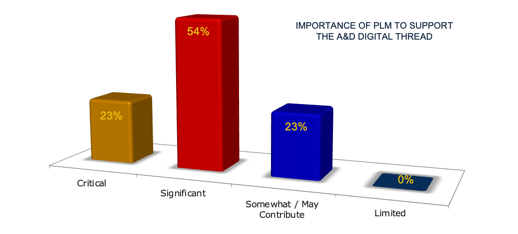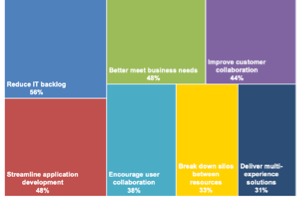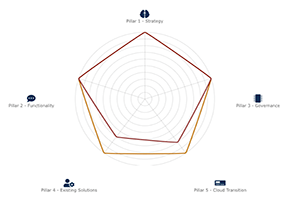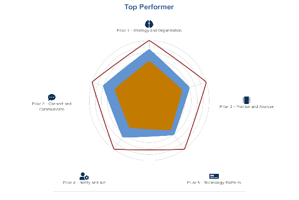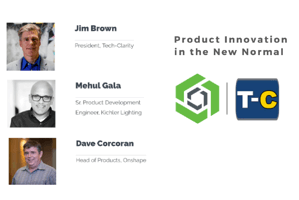With increasing demands for highly skilled operators, yet a shortage of workers with those skills, what can manufacturers do to boost manufacturing productivity? With workforce shortages, market volatility, and rising costs plaguing most manufacturers, many are turning to new ways of operating, and digital transformation is playing a pivotal role. Digital work instructions can be…
- Challenges Facing Manufacturers
- What Are Digital Work Instructions?
- Ten Ways Digital Work Instructions Help
- 1. Connectivity to Existing Systems
- 2. Single Point of Access
- 3. Traceability from Engineering to Manufacturing
- 4. Supports Roll out of New or Customized Products
- 5. Real-Time Process Control
- 6. Analytics to Optimize Work Instructions
- 7. Hardware Agnostic
- 8. User friendly and Easy to Adopt
- 9. Good Vendor Support
- Select the Right Solution for Your Needs
- Acknowledgments
What Are Digital Work Instructions?
Industrial Internet of Things (IIoT) The IIoT integrates many technologies in a factory. It can create a digital thread across the product lifecycle, enabling traceability to support greater efficiency, improve quality, and support regulatory compliance. For many, investments in IIoT will likely create a competitive advantage, especially during a downturn. There are many different approaches to start with IIoT adoption. One way is with digital work instructions. The Difference Between Digital and Electronic
While digital work instructions support going paperless, digital is not the same as electronic. While an electronic format such as a PDF offers the benefits of going paperless, it does not provide all of the benefits of going digital. A PDF is still a dumb document. The minute you create it, you break the digital thread. The document has no link to its source data, so as soon as there are changes, the PDF is outdated.
Digital Work Instructions
On the other hand, digital work instructions are smart and data-driven. They preserve the digital thread from the engineering data and connect it to the produced product. Digital work instructions dynamically guide operators as they work, providing instructions in a digestible way that is easy to follow. The software can pull data from multiple places, yet only show the operator what’s relevant to the current task, from a single screen. Work instructions are never out of date since they automatically update when there are changes. With connectivity, the software also captures what the operators do. This closed loop visibility validates that the instructions were executed properly and provides management with visibility, supporting continuous improvement.
The Difference Between Digital and Electronic
While digital work instructions support going paperless, digital is not the same as electronic. While an electronic format such as a PDF offers the benefits of going paperless, it does not provide all of the benefits of going digital. A PDF is still a dumb document. The minute you create it, you break the digital thread. The document has no link to its source data, so as soon as there are changes, the PDF is outdated.
Digital Work Instructions
On the other hand, digital work instructions are smart and data-driven. They preserve the digital thread from the engineering data and connect it to the produced product. Digital work instructions dynamically guide operators as they work, providing instructions in a digestible way that is easy to follow. The software can pull data from multiple places, yet only show the operator what’s relevant to the current task, from a single screen. Work instructions are never out of date since they automatically update when there are changes. With connectivity, the software also captures what the operators do. This closed loop visibility validates that the instructions were executed properly and provides management with visibility, supporting continuous improvement.
Select the Right Solution for Your Needs
Recommendations Based on industry experience and research for this report, Tech-Clarity has identified the following criteria to select the right solution for digital work instructions:- Connectivity to existing systems
- Single point of access
- Traceability from engineering to manufacturing
- Supports roll out of new products or customized products
- Real-time process control
- Analytics to optimize work instructions
- Hardware agnostic
- User friendly and easy to adopt
- Good vendor support
 What role does software play in the maturation of additive manufacturing to industrial scale?
This live webcast, hosted by Jim Brown and Igor Tsinman, President of AMC Bridge, explores the symbiotic relationship between additive manufacturing technology and the software applications that work cohesively with them. The panel includes Igal Kaptsan - General Manager Software of GE Additive and Moritz Maier - Co-Funder & Co-CEO of ELISE.
What role does software play in the maturation of additive manufacturing to industrial scale?
This live webcast, hosted by Jim Brown and Igor Tsinman, President of AMC Bridge, explores the symbiotic relationship between additive manufacturing technology and the software applications that work cohesively with them. The panel includes Igal Kaptsan - General Manager Software of GE Additive and Moritz Maier - Co-Funder & Co-CEO of ELISE.
 Register now to watch the May 13 webcast.
[post_title] => How Software Enables Industrial Additive Manufacturing (webcast)
[post_excerpt] =>
[post_status] => publish
[comment_status] => open
[ping_status] => open
[post_password] =>
[post_name] => industrial-additive-webcast
[to_ping] =>
[pinged] =>
[post_modified] => 2022-11-14 22:27:05
[post_modified_gmt] => 2022-11-15 03:27:05
[post_content_filtered] =>
[post_parent] => 0
[guid] => https://tech-clarity.com/?p=10420
[menu_order] => 0
[post_type] => post
[post_mime_type] =>
[comment_count] => 0
[filter] => raw
)
[2] => WP_Post Object
(
[ID] => 10406
[post_author] => 2572
[post_date] => 2021-04-28 18:38:15
[post_date_gmt] => 2021-04-28 22:38:15
[post_content] =>
Register now to watch the May 13 webcast.
[post_title] => How Software Enables Industrial Additive Manufacturing (webcast)
[post_excerpt] =>
[post_status] => publish
[comment_status] => open
[ping_status] => open
[post_password] =>
[post_name] => industrial-additive-webcast
[to_ping] =>
[pinged] =>
[post_modified] => 2022-11-14 22:27:05
[post_modified_gmt] => 2022-11-15 03:27:05
[post_content_filtered] =>
[post_parent] => 0
[guid] => https://tech-clarity.com/?p=10420
[menu_order] => 0
[post_type] => post
[post_mime_type] =>
[comment_count] => 0
[filter] => raw
)
[2] => WP_Post Object
(
[ID] => 10406
[post_author] => 2572
[post_date] => 2021-04-28 18:38:15
[post_date_gmt] => 2021-04-28 22:38:15
[post_content] => 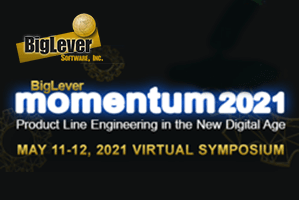 What role should feature-based Product Line Engineering (PLE) play in a digital transformation strategy?
On May 11-12, 2021, Big Lever will be holding their Momentum 2021 Symposium and this question will be the underlying theme of the event.
Tech-Clarity’s Michelle Boucher will join the list of speakers and she will explore the question, why should business leaders care about PLE? Her talk will be at 1:45 EDT on Tuesday, May 11. You can register for the event here.
As products continue to grow in complexity, engineering jobs will only get harder. Digital transformation can help, and for many companies, this last year has dramatically accelerated adoption. With this growing adoption, what steps should you take to ensure you don’t fall behind your competition? Michelle’s talk will discuss how PLE fits into the digital transformation vision and the impact on the business. She will also explain how providing engineers with better solutions for PLE will help to execute a digital transformation strategy, while empowering your engineers to focus more on innovation and less on tedious tasks.
What role should feature-based Product Line Engineering (PLE) play in a digital transformation strategy?
On May 11-12, 2021, Big Lever will be holding their Momentum 2021 Symposium and this question will be the underlying theme of the event.
Tech-Clarity’s Michelle Boucher will join the list of speakers and she will explore the question, why should business leaders care about PLE? Her talk will be at 1:45 EDT on Tuesday, May 11. You can register for the event here.
As products continue to grow in complexity, engineering jobs will only get harder. Digital transformation can help, and for many companies, this last year has dramatically accelerated adoption. With this growing adoption, what steps should you take to ensure you don’t fall behind your competition? Michelle’s talk will discuss how PLE fits into the digital transformation vision and the impact on the business. She will also explain how providing engineers with better solutions for PLE will help to execute a digital transformation strategy, while empowering your engineers to focus more on innovation and less on tedious tasks.
About the Event
In addition to Michelle, other speakers will include:- David Long, President, Vitech: Beyond Digital: Bridging the Divides
- Dr. Bobbi Young, Systems Engineering Fellow, Raytheon: Digital Transformation: Composing Your Digital Future
- Dr. Charles Krueger, CEO, BigLever: Product Line Engineering in the New Digital Age
- Eric MacKnight, Staff Engineer, GE Aviation: General Electric Aviation’s Use of Product Line Engineering and Model-based Systems Engineering
- Panel Discussion
- Sandy Friedenthal, Co-lead for OMG SysML V2 Submission Team: Model-Based Systems Engineering (MBSE) and the Digital Transformation
- Rick Flores, Technical Fellow, General Motors & Halim Ragab, Engineering Specialist, General Motors: Application of PLE in MBSE for an AUTOSAR-based Digital Supply Chain
- Bill Schindel, President, ICTT System Sciences: The Forces of Modularity: Macro and Micro Patterns in the Innovation Ecosystem
- Rowland Darbin, INCOSE PLE Working Group Chair: INCOSE Product Line Engineering International Working Group Perspectives on Modern Feature-based PLE
- Dr. William Donaldson, President & Founder, Strategic Venture Planning: We need to talk: Enabling the Conversation Between Business and Engineering about Organizational Change for Digital Transformation, Digital Engineering, and PLE
- Roger McNicholas, VP, General Dynamics Mission Systems: Application of PLE to US Army Live Training
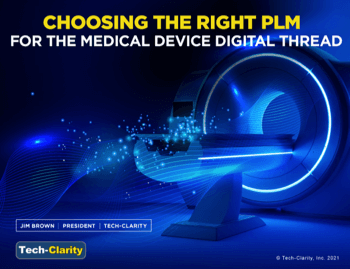 How can PLM enable medical device companies to streamline engineering and create digital continuity with a cohesive medical device digital thread? What should they look for in a PLM solution to improve closed-loop quality and patient outcomes while meeting complex, regional compliance demands?
This eBook takes a deeper dive into the data from our original, cross-industry digital thread study to better understand how the value and considerations for digital thread adoption apply to medical device manufacturers.
Please enjoy the summary* below. For the full research, please visit our sponsor PTC (registration required).
How can PLM enable medical device companies to streamline engineering and create digital continuity with a cohesive medical device digital thread? What should they look for in a PLM solution to improve closed-loop quality and patient outcomes while meeting complex, regional compliance demands?
This eBook takes a deeper dive into the data from our original, cross-industry digital thread study to better understand how the value and considerations for digital thread adoption apply to medical device manufacturers.
Please enjoy the summary* below. For the full research, please visit our sponsor PTC (registration required).
Table of Contents
- Introducing the Buyer's Guide
- The Digital Thread Imperative
- What to Look for to Streamline Engineering
- What to Look for to Closed-Loop Quality, Continuity
- Digital Thread Business Value
- Considerations by Role - Engineering
- Considerations by Role - Manufacturing
- Considerations by Role - Quality
- Considerations by Role - IT
- Considerations by Role - Service
- PLM is the Digital Thread Backbone
- Special Considerations - Emerging Technologies
- Implementation Considerations
- Vendor Considerations
- Conclusions and Next Steps
- About the Research
- Acknowledgments
The Medical Device Digital Thread Imperative
Business Strategies Demand a Cohesive Digital Thread Over three-quarters of companies say that the digital thread is either important or critical to achieving their business strategy. About one-half of medical device manufacturers indicate they have already implemented a digital thread initiative, most likely to meet design control mandates such as Design History File (DHF) and Device Master Record (DMR) and rapidly changing, region-specific regulatory requirements such as EU Medical Device Regulation (MDR). Medical device manufacturers report a variety of important goals for their digital thread initiative (see chart). They are 30% more likely than other manufacturers to pursue compliance, for example seeking audit-ready data. They are investing in reducing errors and adverse events to improve patient outcomes, all while trying to control the cost of quality and compliance overhead. While definitions vary, medical device manufacturers are looking for quality, compliance, and streamlined engineering from the digital thread. Streamlined Engineering The digital thread streamlines design by allowing product development teams to share and reuse design data across the stages of innovation. Design continuity along the digital thread allows engineers to add their design information to a cohesive model, directly incorporating and extending design data from prior steps – allowing them to efficiently design for regulatory management. Continuity, Closed Loop Quality The digital thread ties product information, decisions, and history together in a structured, integrated way that captures product innovation and knowledge throughout the product lifecycle. It establishes traceability from early in the front end of innovation through development, manufacturing, service, and field operation. This continuity ensures data-driven handovers between departments and support for evolving global regulations, initiatives, and standards including the FDA’s Case for Quality (CfQ) and Quality System Regulation (QSR), ISO 13485, and the new EU MDR/EU IVDR.Conclusions and Next Steps
Invest in the Digital Thread Invest in the digital thread to streamline engineering and create digital continuity. Top Performers are 2.6 times as likely to view the digital thread as critical to supporting their business strategy. Extend the Thread across the Lifecycle Adopt a comprehensive scope that incorporates cross-departmental data. Top Performers are more likely to include manufacturing, quality, and service plans in the scope of their digital thread, and enrich it with actual data from the IoT. Leverage PLM as the Digital Medical Device Backbone for Closed-Loop Quality, Continuity, and Streamlined Engineering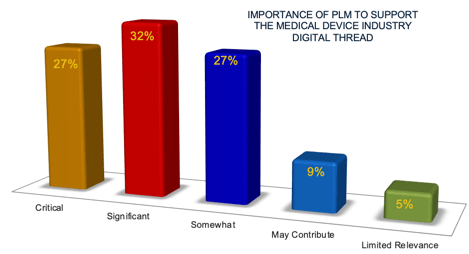 Adopt PLM to support the digital thread. Top Performing companies are 2.4 times as likely to view PLM as critical to supporting the digital thread and are much more likely to use PLM to support it.
Enjoy the Benefits
The digital thread provides significant, measurable benefits including improved quality, increased engineering efficiency, enhanced innovation, faster time to market, and better compliance. Top Performers gain even higher benefits than others. For example, these more successful product developers enable their technical resources to spend 27% more time, on average, on value-added activities than their poorer performing counterparts.
*This summary is an abbreviated version of the ebook and does not contain the full content. For the full research, please visit our sponsor PTC (registration required).
If you have difficulty obtaining a copy of the research, please contact us.
[post_title] => PLM for the Medical Device Digital Thread (buyer's guide)
[post_excerpt] =>
[post_status] => publish
[comment_status] => open
[ping_status] => open
[post_password] =>
[post_name] => plm-for-medical-device-digital-thread-survey-results
[to_ping] =>
[pinged] =>
[post_modified] => 2022-11-14 22:28:02
[post_modified_gmt] => 2022-11-15 03:28:02
[post_content_filtered] =>
[post_parent] => 0
[guid] => https://tech-clarity.com/?p=10369
[menu_order] => 0
[post_type] => post
[post_mime_type] =>
[comment_count] => 0
[filter] => raw
)
[4] => WP_Post Object
(
[ID] => 10360
[post_author] => 2
[post_date] => 2021-04-16 12:49:56
[post_date_gmt] => 2021-04-16 16:49:56
[post_content] =>
Adopt PLM to support the digital thread. Top Performing companies are 2.4 times as likely to view PLM as critical to supporting the digital thread and are much more likely to use PLM to support it.
Enjoy the Benefits
The digital thread provides significant, measurable benefits including improved quality, increased engineering efficiency, enhanced innovation, faster time to market, and better compliance. Top Performers gain even higher benefits than others. For example, these more successful product developers enable their technical resources to spend 27% more time, on average, on value-added activities than their poorer performing counterparts.
*This summary is an abbreviated version of the ebook and does not contain the full content. For the full research, please visit our sponsor PTC (registration required).
If you have difficulty obtaining a copy of the research, please contact us.
[post_title] => PLM for the Medical Device Digital Thread (buyer's guide)
[post_excerpt] =>
[post_status] => publish
[comment_status] => open
[ping_status] => open
[post_password] =>
[post_name] => plm-for-medical-device-digital-thread-survey-results
[to_ping] =>
[pinged] =>
[post_modified] => 2022-11-14 22:28:02
[post_modified_gmt] => 2022-11-15 03:28:02
[post_content_filtered] =>
[post_parent] => 0
[guid] => https://tech-clarity.com/?p=10369
[menu_order] => 0
[post_type] => post
[post_mime_type] =>
[comment_count] => 0
[filter] => raw
)
[4] => WP_Post Object
(
[ID] => 10360
[post_author] => 2
[post_date] => 2021-04-16 12:49:56
[post_date_gmt] => 2021-04-16 16:49:56
[post_content] => 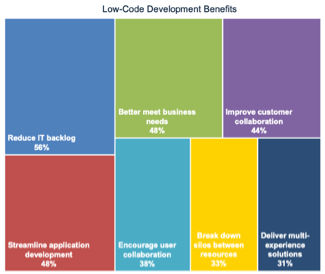 How can low-code help fill digital transformation gaps to help companies achieve the value of IoT opportunities? Jim Brown's guest post on Siemen's blog shows how companies can fill IoT gaps with low-code applications.
Below is a short summary, click here to read Jim Brown's full guest post on the Siemen's blog.
Digital Transformation Creates Opportunities
Today’s digital revolution is creating new opportunities for industrial companies. New business strategies powered by digital technologies are fundamentally changing the business landscape. Companies recognize they need to move quickly. As our Business Sustainability (and Survival) Strategies 2020 survey found, “Almost one-half of businesses (46%) have increased focus and/or accelerated digital transformation due to the pandemic.”
Digital Transformation Creates Gaps
Companies need to find ways to take advantage of the data and opportunities generated by the IoT. They need to figure out how to:
How can low-code help fill digital transformation gaps to help companies achieve the value of IoT opportunities? Jim Brown's guest post on Siemen's blog shows how companies can fill IoT gaps with low-code applications.
Below is a short summary, click here to read Jim Brown's full guest post on the Siemen's blog.
Digital Transformation Creates Opportunities
Today’s digital revolution is creating new opportunities for industrial companies. New business strategies powered by digital technologies are fundamentally changing the business landscape. Companies recognize they need to move quickly. As our Business Sustainability (and Survival) Strategies 2020 survey found, “Almost one-half of businesses (46%) have increased focus and/or accelerated digital transformation due to the pandemic.”
Digital Transformation Creates Gaps
Companies need to find ways to take advantage of the data and opportunities generated by the IoT. They need to figure out how to:
- Connect and communicate with equipment or products
- Monitor and analyze data and performance
- Notify and act on the findings
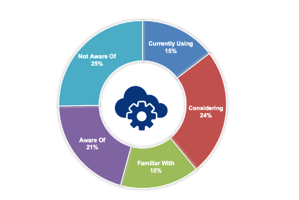 Digital transformation creates, exposes, and widens gaps in processes, organizational approaches, and systems. This leads 96% of industrial companies to say they need to create and implement new software more quickly. Addressing these application shortfalls is critical to long-term business success. Is developing applications with low-code the answer to filling the gaps? We surveyed over 300 manufacturers to find out.
Our new eBook, Filling Digital Transformation Gaps with Low-Code, looks at the challenges companies face today and how low-code development approaches can help.
Please enjoy the summary* below. For the full research, please visit our sponsor Siemens (registration required).
Digital transformation creates, exposes, and widens gaps in processes, organizational approaches, and systems. This leads 96% of industrial companies to say they need to create and implement new software more quickly. Addressing these application shortfalls is critical to long-term business success. Is developing applications with low-code the answer to filling the gaps? We surveyed over 300 manufacturers to find out.
Our new eBook, Filling Digital Transformation Gaps with Low-Code, looks at the challenges companies face today and how low-code development approaches can help.
Please enjoy the summary* below. For the full research, please visit our sponsor Siemens (registration required).
Table of Contents
- Digital Transformation Demands Development Agility
- Examining Digital Transformation Gaps
- Challenges
- Filling Digital Transformation Gaps
- IT Capabilities
- Exploring Low-Code Development
- Benefits
- Conclusions
- About the Research
- Acknowledgments
Digital Transformation
Digital Transformation Puts Pressure on Development Digital transformation is crucial to the success and profitability of today’s industrial companies. But transitioning to a digital business exposes shortfalls and creates gaps in most companies’ software ecosystems. Manufacturers must fill the gaps in their company’s processes, organizational approaches, and systems. Developing solutions to meet digital demands puts significant pressure on application development to do more – and do it faster! How can manufacturers improve the way they develop software applications to fill their digital transformation gaps and achieve their business strategies? We surveyed over 300 manufacturers to find out.Digital Transformation Demands Development Agility
Business Risk Survey respondents share that the digital transformation trend in manufacturing impacts companies in many ways. Digitalization creates business complexity and risk that challenge company viability. Our research shows that about three-quarters of companies shared that business risk and disruption increased for their market over the last five years, and a full one-half of companies with over 10,000 employees said that it had grown “significantly.” These risks demand rapid responses. Demand for Agility The most commonly reported business benefit is the flexibility to work anytime / anywhere, reported by two-thirds of participants. This is followed by ease of collaboration. This capability, along with the ability to have more integrated workflows as reported by about one-half of companies, allows OEMs and the supply chain to work together more efficiently and effectively. This is particularly important for Automotive companies given the global nature of their business, the need to be agile, and the integrated nature of the automotive value chain. Impact on Software Development Digital transformation’s impact on software needs is dramatic. It creates the need to update legacy solutions built for different times and increases the demand to integrate systems and people. It generates the need for new kinds of solutions, including personalized solutions that provide simpler, more focused “apps” that help users accomplish a task and the need to implement new technologies such as Artificial Intelligence (AI) and Augmented Reality (AR). Companies can’t expect to meet these demands if they continue developing solutions in the same way they have been.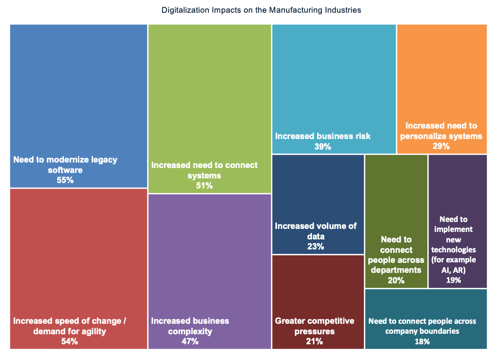
Conclusions
Digital Transformation Gaps Manufacturers are keenly aware that digital transformation increases business complexity and risk. Digitalization increases the speed of change, demands more agility, and creates the need for more (and faster) software development. The vast majority of companies have gaps across the digital transformation initiatives they are pursuing. Few companies can fill these gaps very well. This disadvantage is partly due to technical challenges and partly due to their poor ability to collaborate with critical subject matter experts. Filling Gaps with Low-Code Companies must fill their gaps and they are doing so by both building and buying solutions. Low-code development provides them with the ability to build custom their solutions faster. It also enables companies to integrate and extend their COTS solutions more rapidly. Although still in early adoption, low-code development addresses companies’ technical challenges, creates development agility, and supports collaboration so manufacturers can efficiently modernize legacy systems and deploy new applications. The result is that manufacturers using low-code development are better able to fill their digital transformation gaps. We believe that low-code development is a critical capability to explore to drive overall digital transformation efforts. *This summary is an abbreviated version of the ebook and does not contain the full content. For the full research, please visit our sponsor Siemens (registration required). If you have difficulty obtaining a copy of the research, please contact us. [post_title] => Can Low-Code Fill Gaps in Digital Transformation (survey results) [post_excerpt] => [post_status] => publish [comment_status] => open [ping_status] => open [post_password] => [post_name] => low-code-digital-transformation [to_ping] => [pinged] => [post_modified] => 2024-09-09 20:46:55 [post_modified_gmt] => 2024-09-10 00:46:55 [post_content_filtered] => [post_parent] => 0 [guid] => https://tech-clarity.com/?p=10320 [menu_order] => 0 [post_type] => post [post_mime_type] => [comment_count] => 0 [filter] => raw ) [6] => WP_Post Object ( [ID] => 10309 [post_author] => 2574 [post_date] => 2021-03-08 19:30:42 [post_date_gmt] => 2021-03-09 00:30:42 [post_content] => Could deeper insights lower some manufacturing costs?
For years, continuous improvement programs have successfully lowered operating costs. Now, companies are using advanced analytics in manufacturing to find even more opportunities. This is not your father’s analytics. Rather, it correlates among different data sources, including IoT, to deliver fresh insights for confidently moving to reduce costs.
Julie Fraser's guest post on PTC’s blog outlines what advanced analytics is and the technologies that support it. Then it explores how advanced analytics can help save costs on asset maintenance and related production problems, reduce energy costs, and keep employees and communities safe. This short read will give you a new foundation to consider ways that advanced analytics in manufacturing might lower costs.
For related research, read Lower Six Manufacturing Costs with IoT. This eBook explores how advanced analytics works with other technologies to reduce costs in a manufacturing plant.
[post_title] => How Advanced Analytics in Manufacturing Can Lead to Cost Cuts (guest post)
[post_excerpt] =>
[post_status] => publish
[comment_status] => open
[ping_status] => open
[post_password] =>
[post_name] => advanced-analytics-in-manufacturing
[to_ping] =>
[pinged] =>
[post_modified] => 2022-11-14 22:25:40
[post_modified_gmt] => 2022-11-15 03:25:40
[post_content_filtered] =>
[post_parent] => 0
[guid] => https://tech-clarity.com/?p=10309
[menu_order] => 0
[post_type] => post
[post_mime_type] =>
[comment_count] => 0
[filter] => raw
)
[7] => WP_Post Object
(
[ID] => 10280
[post_author] => 2574
[post_date] => 2021-03-03 12:55:50
[post_date_gmt] => 2021-03-03 17:55:50
[post_content] =>
Could deeper insights lower some manufacturing costs?
For years, continuous improvement programs have successfully lowered operating costs. Now, companies are using advanced analytics in manufacturing to find even more opportunities. This is not your father’s analytics. Rather, it correlates among different data sources, including IoT, to deliver fresh insights for confidently moving to reduce costs.
Julie Fraser's guest post on PTC’s blog outlines what advanced analytics is and the technologies that support it. Then it explores how advanced analytics can help save costs on asset maintenance and related production problems, reduce energy costs, and keep employees and communities safe. This short read will give you a new foundation to consider ways that advanced analytics in manufacturing might lower costs.
For related research, read Lower Six Manufacturing Costs with IoT. This eBook explores how advanced analytics works with other technologies to reduce costs in a manufacturing plant.
[post_title] => How Advanced Analytics in Manufacturing Can Lead to Cost Cuts (guest post)
[post_excerpt] =>
[post_status] => publish
[comment_status] => open
[ping_status] => open
[post_password] =>
[post_name] => advanced-analytics-in-manufacturing
[to_ping] =>
[pinged] =>
[post_modified] => 2022-11-14 22:25:40
[post_modified_gmt] => 2022-11-15 03:25:40
[post_content_filtered] =>
[post_parent] => 0
[guid] => https://tech-clarity.com/?p=10309
[menu_order] => 0
[post_type] => post
[post_mime_type] =>
[comment_count] => 0
[filter] => raw
)
[7] => WP_Post Object
(
[ID] => 10280
[post_author] => 2574
[post_date] => 2021-03-03 12:55:50
[post_date_gmt] => 2021-03-03 17:55:50
[post_content] => Table of Contents
- Executive Overview
- Opportunity Brings Challenges
- Retooling to Lifecycle Management Strategies
- Identifying the Top Performers
- Business Capabilities Matter
- Top Performers Manage Product Data Better
- Organizing and Supporting People for Success
- Semiconductor’s Complex Technology Landscape
- Tech-Clarity PLM Value Maturity Model
- Digital Continuity from PLM
- How Semiconductor Companies Differ from Their Customers
- Conclusions
- Recommendations
- About the Author
- About the Research
- Acknowledgments
Overview
Gaining design wins and getting each product into the market profitably is a puzzle. Solving that puzzle repeatedly and reliably is an enterprise- and ecosystem-wide endeavor that requires retooling semiconductor innovation to support that scope. Some appear to have done that. We identified these companies as Top Performers: the companies with the best revenue, profit margin growth, and revenue from products less than two years old. They think and act more holistically. Top Performers have better capabilities for ecosystem collaboration and IP protection, waste less time in product development processes, and have faster time to market. These leaders accomplish their higher performance through better use of commercial technology, including PLM. They have better access to data and digital continuity. Top Performers also exhibit higher digital maturity, managing and sharing data across partners and disciplines. The Top Performers show a way forward for semiconductor, electronics, and high-tech companies.Conclusions
Every aspect of life increasingly depends on semiconductors and electronics to become smarter. Opportunity is growing. Yet to seize it, companies must retool innovation in not only product technology but also enterprise and ecosystem processes. Remember, success rests on achieving product quality, reliability, performance, innovativeness, and cost all at once. Beating the competition in all those ways is no small feat. Top Performers’ Holistic View What differentiates Top Performers from Others is how much they have done to ensure their business and product innovation work effectively. They are better at cross-functional and multi-partner processes than others. Rather than settling for trade-offs, they have developed capabilities to balance all the objectives. They can design successful innovative products while at the same time being efficient and protecting their IP. This balanced view and set of capabilities enable them to get to market faster and more confidently with lower operating costs.- managing their product data, whether BOMs, BOPs, simulation data, or IP
- digital continuity
- data access through the lifecycle
- using PDM or PLM technologies
- collaboration across their enterprise, ecosystem, and product lifecycle.
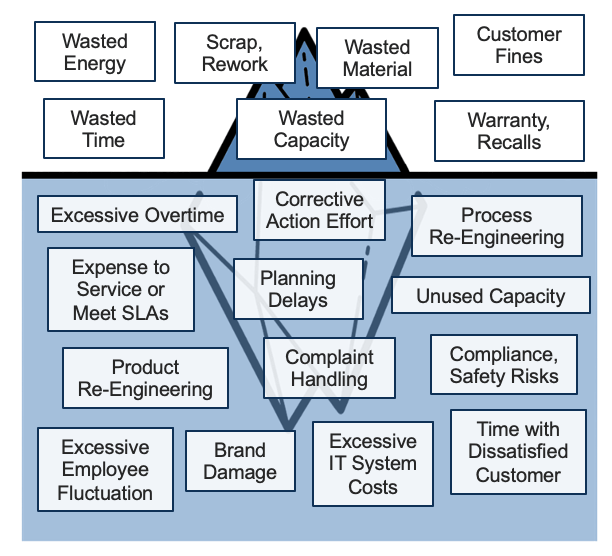 What does Poor Quality Really Cost?
Calculating the actual cost of quality problems is not straightforward. Some of the expenses are apparent, but many are not. Quality is important to customers and to business profitability. So, truly understanding the cost of quality warrants the effort. Fortunately, advanced manufacturing technologies can help analyze and understand expenses plus reduce quality problems and escapes.
Julie Fraser's guest post on PTC’s blog outlines some ways advanced manufacturing technologies can help avoid quality problems, spot patterns to improve processes, and improve team communication. Explore this to consider whether you’ve included all of the costs of poor quality and prevented them in your operation.
For related research, read Lower Six Manufacturing Costs with IoT to explore how new technologies can help keep manufacturing expenses in check.
[post_title] => What is the Cost of Poor Quality in Your Manufacturing Environment? (guest post)
[post_excerpt] =>
[post_status] => publish
[comment_status] => open
[ping_status] => open
[post_password] =>
[post_name] => cost-of-poor-quality-blog
[to_ping] =>
[pinged] =>
[post_modified] => 2022-11-14 22:25:39
[post_modified_gmt] => 2022-11-15 03:25:39
[post_content_filtered] =>
[post_parent] => 0
[guid] => https://tech-clarity.com/?p=10249
[menu_order] => 0
[post_type] => post
[post_mime_type] =>
[comment_count] => 0
[filter] => raw
)
[9] => WP_Post Object
(
[ID] => 10222
[post_author] => 2574
[post_date] => 2021-02-16 09:08:02
[post_date_gmt] => 2021-02-16 14:08:02
[post_content] =>
What does Poor Quality Really Cost?
Calculating the actual cost of quality problems is not straightforward. Some of the expenses are apparent, but many are not. Quality is important to customers and to business profitability. So, truly understanding the cost of quality warrants the effort. Fortunately, advanced manufacturing technologies can help analyze and understand expenses plus reduce quality problems and escapes.
Julie Fraser's guest post on PTC’s blog outlines some ways advanced manufacturing technologies can help avoid quality problems, spot patterns to improve processes, and improve team communication. Explore this to consider whether you’ve included all of the costs of poor quality and prevented them in your operation.
For related research, read Lower Six Manufacturing Costs with IoT to explore how new technologies can help keep manufacturing expenses in check.
[post_title] => What is the Cost of Poor Quality in Your Manufacturing Environment? (guest post)
[post_excerpt] =>
[post_status] => publish
[comment_status] => open
[ping_status] => open
[post_password] =>
[post_name] => cost-of-poor-quality-blog
[to_ping] =>
[pinged] =>
[post_modified] => 2022-11-14 22:25:39
[post_modified_gmt] => 2022-11-15 03:25:39
[post_content_filtered] =>
[post_parent] => 0
[guid] => https://tech-clarity.com/?p=10249
[menu_order] => 0
[post_type] => post
[post_mime_type] =>
[comment_count] => 0
[filter] => raw
)
[9] => WP_Post Object
(
[ID] => 10222
[post_author] => 2574
[post_date] => 2021-02-16 09:08:02
[post_date_gmt] => 2021-02-16 14:08:02
[post_content] => 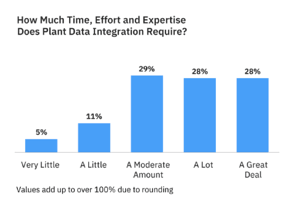 What current challenge have manufacturers been wrestling with for at least 35 years?
System integration. Getting manufacturing data to flow has always been a problem. And it still is.
Based on Tech-Clarity research The Manufacturing Data Challenge: Lessons from Top Performers, most of the 300 respondents’ companies need better ways to integrate IT and OT data. Consistency and context are essential to better data management.
Read Julie Fraser’s guest blog on the Critical Manufacturing site. The post points to just how essential – and possible – better and more integrated manufacturing data management is today.
[post_title] => Manufacturing Data: Can It Finally Flow? (guest blog)
[post_excerpt] =>
[post_status] => publish
[comment_status] => open
[ping_status] => open
[post_password] =>
[post_name] => manufacturing-data-guest-blog
[to_ping] =>
[pinged] =>
[post_modified] => 2022-11-14 22:26:06
[post_modified_gmt] => 2022-11-15 03:26:06
[post_content_filtered] =>
[post_parent] => 0
[guid] => https://tech-clarity.com/?p=10222
[menu_order] => 0
[post_type] => post
[post_mime_type] =>
[comment_count] => 0
[filter] => raw
)
[10] => WP_Post Object
(
[ID] => 10193
[post_author] => 2574
[post_date] => 2021-02-09 15:08:11
[post_date_gmt] => 2021-02-09 20:08:11
[post_content] =>
What current challenge have manufacturers been wrestling with for at least 35 years?
System integration. Getting manufacturing data to flow has always been a problem. And it still is.
Based on Tech-Clarity research The Manufacturing Data Challenge: Lessons from Top Performers, most of the 300 respondents’ companies need better ways to integrate IT and OT data. Consistency and context are essential to better data management.
Read Julie Fraser’s guest blog on the Critical Manufacturing site. The post points to just how essential – and possible – better and more integrated manufacturing data management is today.
[post_title] => Manufacturing Data: Can It Finally Flow? (guest blog)
[post_excerpt] =>
[post_status] => publish
[comment_status] => open
[ping_status] => open
[post_password] =>
[post_name] => manufacturing-data-guest-blog
[to_ping] =>
[pinged] =>
[post_modified] => 2022-11-14 22:26:06
[post_modified_gmt] => 2022-11-15 03:26:06
[post_content_filtered] =>
[post_parent] => 0
[guid] => https://tech-clarity.com/?p=10222
[menu_order] => 0
[post_type] => post
[post_mime_type] =>
[comment_count] => 0
[filter] => raw
)
[10] => WP_Post Object
(
[ID] => 10193
[post_author] => 2574
[post_date] => 2021-02-09 15:08:11
[post_date_gmt] => 2021-02-09 20:08:11
[post_content] =>  How can IoT and advanced technologies lower costs in manufacturing? Lower Six Manufacturing Costs with IoT explores how new technologies can help keep age-old manufacturing expenses in check. The report discusses how the Internet of Things (IoT) and related technologies for monitoring and using data can streamline processes and support people in making profitable decisions.
Please enjoy the summary* below. Please visit our sponsor PTC for the full research (registration required).
How can IoT and advanced technologies lower costs in manufacturing? Lower Six Manufacturing Costs with IoT explores how new technologies can help keep age-old manufacturing expenses in check. The report discusses how the Internet of Things (IoT) and related technologies for monitoring and using data can streamline processes and support people in making profitable decisions.
Please enjoy the summary* below. Please visit our sponsor PTC for the full research (registration required).
Table of Contents
- Cost and Margin
- Workforce Productivity
- Material Costs
- Asset Costs
- Energy Costs
- Cost of Quality
- Safety and Compliance Costs
- Recommendations
- Acknowledgments
Cost and Margin
Age-old Manufacturing Challenges Margins matter. Ever since people began turning materials into higher-value goods and selling them for a living, lowering costs has been an objective for manufacturers. In the margin equation (simplified to income minus expenses), costs are often the easiest to control. For manufacturers, operating costs are a logical place to seek improvement. Manufacturing inherently has a set of input costs: workforce, materials, machinery, energy; lowering those costs improves operating margin. Problems with quality, safety, or compliance can add to the margin squeeze. Smarter Manufacturing to Lower Costs Each advancement in production methods and information technology has allowed better and less expensive production. Previous moves from artisans to steam power to mass production to control automation have each done this. Costs continue to drop with the transition to IT in operations and today’s IoT-connected distributed intelligence. Yet those savings require initial investments to create a smart connected factory. New technologies offer specific ways to reduce costs. We’ll show them in six primary areas:- Workforce productivity
- Materials
- Assets
- Energy
- Quality
- Safety & Compliance
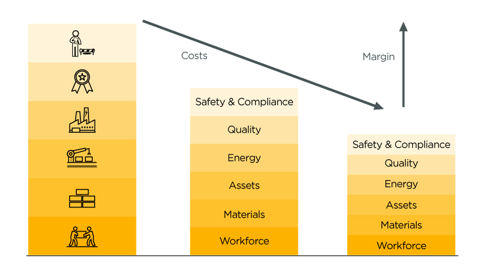
Recommendations
Continuing Cost Reductions Cost improvements are crucial for manufacturers to remain profitable in the “new normal.” Fortunately, technologies for every level are now available to reduce operating costs across all six dimensions. Capabilities to bolster include sensing, monitoring, communicating, analyzing, predicting, and displaying operational data and performance indicators. As with previous generations of manufacturing technology, adding new technologies can create incremental – and sometimes dramatic – cost reductions. Some are one-time savings; many continue to reduce costs. Actions to Get Started While every company’s cost structure and situation is different, there are some things every manufacturer should do.- Examine operating costs and focus efforts on significant needs or easy-to-identify wastes.
- Add IoT sensors to gather more data where critical opportunities lurk.
- Provide workers with as much support as possible through work instructions and remote expert support on-line or through AR goggles.
- Use all data feeds available to monitor materials, processes, and equipment precisely.
- Assess energy and quality in detail and add guidance or monitoring to keep costs in line with revenues.
- Consider compliance and EH&S systems – are you still facing risks?
- Consider how new technologies in this paper will integrate with and leverage current automation and software systems.
 How can Aerospace and Defense (A&D) companies streamline collaboration and create digital continuity? What should they look for in a PLM system to support a cohesive digital thread, especially given that their IT systems were not designed for remote work during a pandemic?
This eBook takes a deeper dive into the data from our original, cross-industry study on the digital thread to better understand how the value and considerations for digital thread adoption apply to A&D companies.
Please enjoy the summary* below. For the full research, please visit our sponsor PTC (registration required).
You can also watch our related digital thread webcast.
How can Aerospace and Defense (A&D) companies streamline collaboration and create digital continuity? What should they look for in a PLM system to support a cohesive digital thread, especially given that their IT systems were not designed for remote work during a pandemic?
This eBook takes a deeper dive into the data from our original, cross-industry study on the digital thread to better understand how the value and considerations for digital thread adoption apply to A&D companies.
Please enjoy the summary* below. For the full research, please visit our sponsor PTC (registration required).
You can also watch our related digital thread webcast.
Table of Contents
- Choosing the Right PLM
- Introducing the Buyer's Guide
- The Digital Thread Imperative
- What to Look for to Streamline Engineering
- What to Look for to Create Digital Continuity
- Digital Thread Business Value
- Considerations by Role - Engineering
- Considerations by Role - Manufacturing
- Considerations by Role - Quality
- Considerations by Role - IT
- Considerations by Role - Service
- PLM is the Digital Thread Backbone
- Special Considerations - Emerging Technologies
- Implementation Considerations
- Vendor Considerations
- Conclusions and Next Steps
- About the Research
- Acknowledgments
The Digital Thread Imperative
Business Strategies Demand a Cohesive Digital ThreadConclusions and Next Steps
Invest in the Digital Thread Tech-Clarity is pleased to announce that we are expanding our research team and extending our coverage of Digital Innovation, Digital Transformation, and Additive Manufacturing. Well-known industry thought leader and research analyst James White is joining Tech-Clarity as Vice President of Digital Innovation Research. James brings with him decades of experience in Digital Enterprise specializing in Digital Transformation, Design Innovation, PLM, Industrial Additive Manufacturing, BIM, and other solution domains essential for engineering manufacturers. Please visit James’ Bio Page for more on his background.
Traditional manufacturing industries are undergoing significant change due to a confluence of events including globalizing supply chains, system-of-systems, emerging SaaS solutions, and multi-cultural teams while aiming to reduce product complexity and optimize portfolios. Leading manufacturers are eliminating the gaps between customer requirements management, product innovation, engineering product development, manufacturing operations, and supply chains by creating a cohesive digital thread. Today’s leading software vendors are evaluating their product portfolio strategies and new SaaS solutions are emerging as disrupters to meet these challenges. Adjacent technologies from solution providers such as Amazon, Microsoft, Google, and peer-to-peer collaboration tools such as Zoom and Slack are also becoming making an impact. Product Innovation Platforms offering CAD, CAE, PDM, and PLM are aligning and integrating much more closely with adjacent solutions including ERP, Supply Chain, MES, QMS, and more.
“This is a strategic move,” explains Jim Brown, President and Founder of Tech-Clarity. “As manufacturers grapple with rapid change while combating global pressures it’s imperative for us to offer a broad strategic perspective on digital transformatoin in 2021 and beyond. More than ever before, we must help companies seek out the value of technology by simultaneously balancing technology against processes and people. James brings great experience, credibility, and a global perspective. We are excited to have such a respected thought leader join our team to help further our mission of making the business value of technology clear.”
James’ research focus will include Digital Innovation, Digital Transformation, PLM, BIM, and Industrial Additive Manufacturing.
Please follow Tech-Clarity on Twitter and join our mailing list to read James’ research. For more information or to schedule a briefing please feel free to contact us.
[post_title] => Tech-Clarity adds Digital Innovation and Transformation Analyst James White
[post_excerpt] =>
[post_status] => publish
[comment_status] => open
[ping_status] => open
[post_password] =>
[post_name] => tech-clarity-adds-james-white
[to_ping] =>
[pinged] =>
[post_modified] => 2022-11-14 22:25:57
[post_modified_gmt] => 2022-11-15 03:25:57
[post_content_filtered] =>
[post_parent] => 0
[guid] => https://tech-clarity.com/?p=10171
[menu_order] => 0
[post_type] => post
[post_mime_type] =>
[comment_count] => 0
[filter] => raw
)
[13] => WP_Post Object
(
[ID] => 10164
[post_author] => 2
[post_date] => 2021-01-31 12:01:52
[post_date_gmt] => 2021-01-31 17:01:52
[post_content] =>
Tech-Clarity is pleased to announce that we are expanding our research team and extending our coverage of Digital Innovation, Digital Transformation, and Additive Manufacturing. Well-known industry thought leader and research analyst James White is joining Tech-Clarity as Vice President of Digital Innovation Research. James brings with him decades of experience in Digital Enterprise specializing in Digital Transformation, Design Innovation, PLM, Industrial Additive Manufacturing, BIM, and other solution domains essential for engineering manufacturers. Please visit James’ Bio Page for more on his background.
Traditional manufacturing industries are undergoing significant change due to a confluence of events including globalizing supply chains, system-of-systems, emerging SaaS solutions, and multi-cultural teams while aiming to reduce product complexity and optimize portfolios. Leading manufacturers are eliminating the gaps between customer requirements management, product innovation, engineering product development, manufacturing operations, and supply chains by creating a cohesive digital thread. Today’s leading software vendors are evaluating their product portfolio strategies and new SaaS solutions are emerging as disrupters to meet these challenges. Adjacent technologies from solution providers such as Amazon, Microsoft, Google, and peer-to-peer collaboration tools such as Zoom and Slack are also becoming making an impact. Product Innovation Platforms offering CAD, CAE, PDM, and PLM are aligning and integrating much more closely with adjacent solutions including ERP, Supply Chain, MES, QMS, and more.
“This is a strategic move,” explains Jim Brown, President and Founder of Tech-Clarity. “As manufacturers grapple with rapid change while combating global pressures it’s imperative for us to offer a broad strategic perspective on digital transformatoin in 2021 and beyond. More than ever before, we must help companies seek out the value of technology by simultaneously balancing technology against processes and people. James brings great experience, credibility, and a global perspective. We are excited to have such a respected thought leader join our team to help further our mission of making the business value of technology clear.”
James’ research focus will include Digital Innovation, Digital Transformation, PLM, BIM, and Industrial Additive Manufacturing.
Please follow Tech-Clarity on Twitter and join our mailing list to read James’ research. For more information or to schedule a briefing please feel free to contact us.
[post_title] => Tech-Clarity adds Digital Innovation and Transformation Analyst James White
[post_excerpt] =>
[post_status] => publish
[comment_status] => open
[ping_status] => open
[post_password] =>
[post_name] => tech-clarity-adds-james-white
[to_ping] =>
[pinged] =>
[post_modified] => 2022-11-14 22:25:57
[post_modified_gmt] => 2022-11-15 03:25:57
[post_content_filtered] =>
[post_parent] => 0
[guid] => https://tech-clarity.com/?p=10171
[menu_order] => 0
[post_type] => post
[post_mime_type] =>
[comment_count] => 0
[filter] => raw
)
[13] => WP_Post Object
(
[ID] => 10164
[post_author] => 2
[post_date] => 2021-01-31 12:01:52
[post_date_gmt] => 2021-01-31 17:01:52
[post_content] =>  James White is the Vice President of Digital Innovation Research for independent research firm Tech-Clarity. He covers the Digital Enterprise specializing in Digital Transformation, Design Innovation, PLM, Industrial Additive Manufacturing, BIM, and other solution areas for manufacturers.
He began his career in special purpose machine design before moving into the CAD/CAE/PLM industry focused on heavy engineering applications. While developing his career in the engineering software industry, Mr. White moved countries 8 times. Through this journey, he gathered valuable multi-cultural experience in a wide range of industries working for leading CAD/CAE/PLM solution companies such as HP, Autodesk, Upchain, and Accenture. He has held senior positions responsible for taking new disruptive products to market. He is particularly interested in the confluence of events currently affecting engineering product development; globalization of supply chains, system-of-systems, emerging SaaS solutions, multi-cultural teams, and the need to reduce complexity and optimize portfolios.
James White has trade certificates in design drafting, fitting/turning/machining, a degree in Mechanical Engineering from Otago University of Dunedin New Zealand, and a Post Graduate Diploma in Marketing/Business Strategy from Monash University, Melbourne Australia.
Mr. White believes that companies achieve the highest value from their initiatives when they allow all stakeholders to contribute. He believes that sometimes the expectations of new technology are too high, new process goals too ambitious, and expectations of people’s ability to change are not clearly understood. Only by evaluating the combination of technology, processes, and people simultaneously can the true value of technology be achieved.
When he’s not focused on investigating the value of technology, he is a competitive ocean swimmer and motorcycle track and adventure rider.
[post_title] => James White
[post_excerpt] =>
[post_status] => publish
[comment_status] => closed
[ping_status] => closed
[post_password] =>
[post_name] => james-white
[to_ping] =>
[pinged] =>
[post_modified] => 2021-02-02 08:55:52
[post_modified_gmt] => 2021-02-02 13:55:52
[post_content_filtered] =>
[post_parent] => 24
[guid] => https://tech-clarity.com/?page_id=10164
[menu_order] => 0
[post_type] => page
[post_mime_type] =>
[comment_count] => 0
[filter] => raw
)
[14] => WP_Post Object
(
[ID] => 10141
[post_author] => 2
[post_date] => 2021-01-25 15:38:39
[post_date_gmt] => 2021-01-25 20:38:39
[post_content] =>
James White is the Vice President of Digital Innovation Research for independent research firm Tech-Clarity. He covers the Digital Enterprise specializing in Digital Transformation, Design Innovation, PLM, Industrial Additive Manufacturing, BIM, and other solution areas for manufacturers.
He began his career in special purpose machine design before moving into the CAD/CAE/PLM industry focused on heavy engineering applications. While developing his career in the engineering software industry, Mr. White moved countries 8 times. Through this journey, he gathered valuable multi-cultural experience in a wide range of industries working for leading CAD/CAE/PLM solution companies such as HP, Autodesk, Upchain, and Accenture. He has held senior positions responsible for taking new disruptive products to market. He is particularly interested in the confluence of events currently affecting engineering product development; globalization of supply chains, system-of-systems, emerging SaaS solutions, multi-cultural teams, and the need to reduce complexity and optimize portfolios.
James White has trade certificates in design drafting, fitting/turning/machining, a degree in Mechanical Engineering from Otago University of Dunedin New Zealand, and a Post Graduate Diploma in Marketing/Business Strategy from Monash University, Melbourne Australia.
Mr. White believes that companies achieve the highest value from their initiatives when they allow all stakeholders to contribute. He believes that sometimes the expectations of new technology are too high, new process goals too ambitious, and expectations of people’s ability to change are not clearly understood. Only by evaluating the combination of technology, processes, and people simultaneously can the true value of technology be achieved.
When he’s not focused on investigating the value of technology, he is a competitive ocean swimmer and motorcycle track and adventure rider.
[post_title] => James White
[post_excerpt] =>
[post_status] => publish
[comment_status] => closed
[ping_status] => closed
[post_password] =>
[post_name] => james-white
[to_ping] =>
[pinged] =>
[post_modified] => 2021-02-02 08:55:52
[post_modified_gmt] => 2021-02-02 13:55:52
[post_content_filtered] =>
[post_parent] => 24
[guid] => https://tech-clarity.com/?page_id=10164
[menu_order] => 0
[post_type] => page
[post_mime_type] =>
[comment_count] => 0
[filter] => raw
)
[14] => WP_Post Object
(
[ID] => 10141
[post_author] => 2
[post_date] => 2021-01-25 15:38:39
[post_date_gmt] => 2021-01-25 20:38:39
[post_content] => 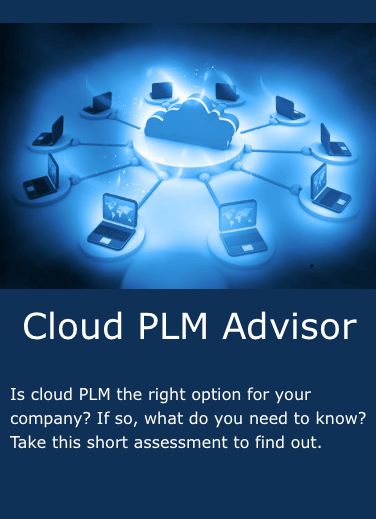 Is cloud PLM the right option for your company? If so, what do you need to know? Take our Cloud PLM Advisor assessment to find out.
The assessment leverages our research to assess your company’s readiness to transition to the cloud. Should you switch to a new system? Wait for your current solution to be available on the cloud? How much functionality are you willing to trade off, if any? Do you have the proper standards in mind?
The assessment considers five pillars of cloud readiness to provide tailored recommendations to help you determine the best path for your business:
Is cloud PLM the right option for your company? If so, what do you need to know? Take our Cloud PLM Advisor assessment to find out.
The assessment leverages our research to assess your company’s readiness to transition to the cloud. Should you switch to a new system? Wait for your current solution to be available on the cloud? How much functionality are you willing to trade off, if any? Do you have the proper standards in mind?
The assessment considers five pillars of cloud readiness to provide tailored recommendations to help you determine the best path for your business:
- Strategy
- Functionality
- Governance
- Existing Solutions
- Cloud Transition
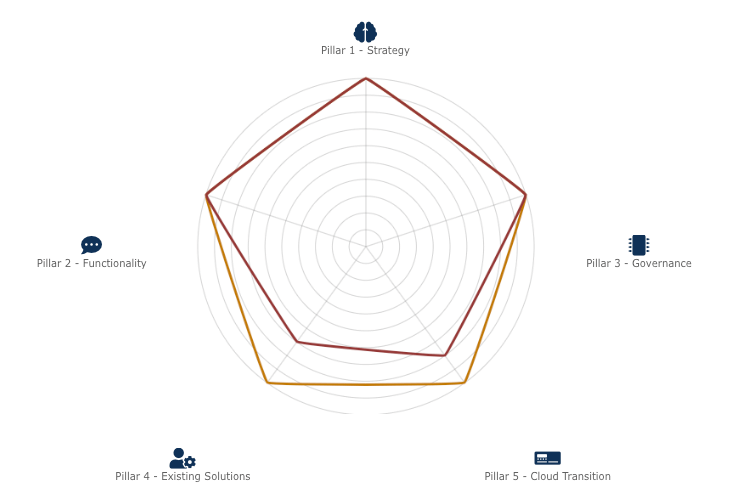 [post_title] => Are You Ready for Cloud PLM? (online assessment)
[post_excerpt] =>
[post_status] => publish
[comment_status] => open
[ping_status] => open
[post_password] =>
[post_name] => cloud-advisor-plm-asssessment
[to_ping] =>
[pinged] =>
[post_modified] => 2022-11-14 22:24:41
[post_modified_gmt] => 2022-11-15 03:24:41
[post_content_filtered] =>
[post_parent] => 0
[guid] => https://tech-clarity.com/?p=10141
[menu_order] => 0
[post_type] => post
[post_mime_type] =>
[comment_count] => 0
[filter] => raw
)
[15] => WP_Post Object
(
[ID] => 10118
[post_author] => 2
[post_date] => 2021-01-15 16:10:07
[post_date_gmt] => 2021-01-15 21:10:07
[post_content] =>
[post_title] => Are You Ready for Cloud PLM? (online assessment)
[post_excerpt] =>
[post_status] => publish
[comment_status] => open
[ping_status] => open
[post_password] =>
[post_name] => cloud-advisor-plm-asssessment
[to_ping] =>
[pinged] =>
[post_modified] => 2022-11-14 22:24:41
[post_modified_gmt] => 2022-11-15 03:24:41
[post_content_filtered] =>
[post_parent] => 0
[guid] => https://tech-clarity.com/?p=10141
[menu_order] => 0
[post_type] => post
[post_mime_type] =>
[comment_count] => 0
[filter] => raw
)
[15] => WP_Post Object
(
[ID] => 10118
[post_author] => 2
[post_date] => 2021-01-15 16:10:07
[post_date_gmt] => 2021-01-15 21:10:07
[post_content] => 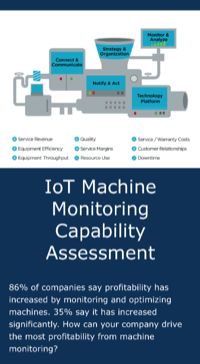 How does your company stack up in its ability to monitor and optimize equipment performance using the IoT? Answer a few questions in our IoT Machine Monitoring Assessment and you’ll get a customized report that:
How does your company stack up in its ability to monitor and optimize equipment performance using the IoT? Answer a few questions in our IoT Machine Monitoring Assessment and you’ll get a customized report that:
- Compares your capabilities to Top Performing companies
- Offers tailored recommendations to improve performance
- Strategy and Organization
- Connect and Communicate with Equipment
- Monitor and Analyze
- Notify and Act
- Technology Platform
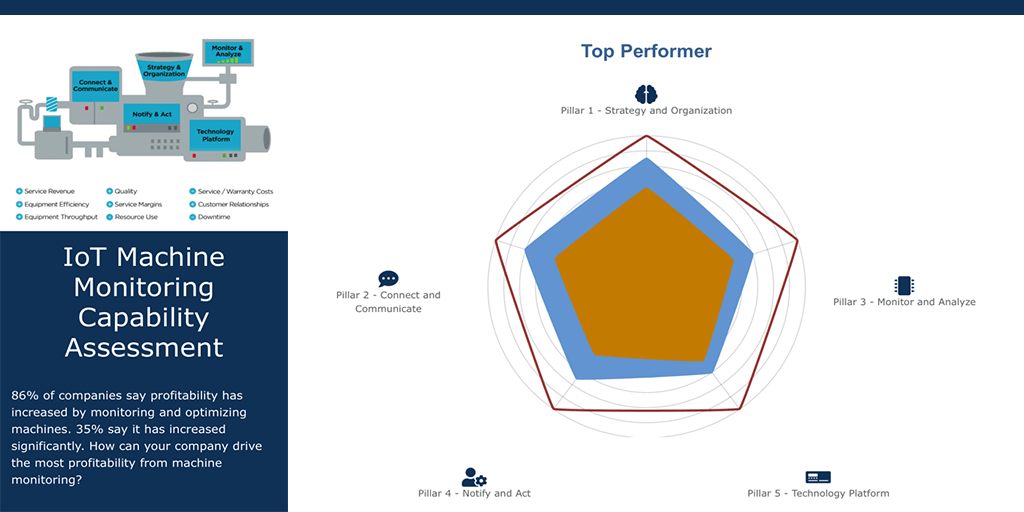 You can also learn more about machine monitoring and optimization and find how to get started by visiting our sponsor, Siemens MindSphere®.
[post_title] => Benchmark Your IoT Machine Monitoring Capability (Performance Assessment)
[post_excerpt] =>
[post_status] => publish
[comment_status] => open
[ping_status] => open
[post_password] =>
[post_name] => machine-monitoring-assessment
[to_ping] =>
[pinged] =>
[post_modified] => 2022-11-14 22:24:41
[post_modified_gmt] => 2022-11-15 03:24:41
[post_content_filtered] =>
[post_parent] => 0
[guid] => https://tech-clarity.com/?p=10118
[menu_order] => 0
[post_type] => post
[post_mime_type] =>
[comment_count] => 0
[filter] => raw
)
[16] => WP_Post Object
(
[ID] => 10109
[post_author] => 2574
[post_date] => 2021-01-14 21:30:20
[post_date_gmt] => 2021-01-15 02:30:20
[post_content] =>
You can also learn more about machine monitoring and optimization and find how to get started by visiting our sponsor, Siemens MindSphere®.
[post_title] => Benchmark Your IoT Machine Monitoring Capability (Performance Assessment)
[post_excerpt] =>
[post_status] => publish
[comment_status] => open
[ping_status] => open
[post_password] =>
[post_name] => machine-monitoring-assessment
[to_ping] =>
[pinged] =>
[post_modified] => 2022-11-14 22:24:41
[post_modified_gmt] => 2022-11-15 03:24:41
[post_content_filtered] =>
[post_parent] => 0
[guid] => https://tech-clarity.com/?p=10118
[menu_order] => 0
[post_type] => post
[post_mime_type] =>
[comment_count] => 0
[filter] => raw
)
[16] => WP_Post Object
(
[ID] => 10109
[post_author] => 2574
[post_date] => 2021-01-14 21:30:20
[post_date_gmt] => 2021-01-15 02:30:20
[post_content] => - Challenges for profitability
- What Top Performers are doing to succeed
- Key process capabilities to improve
- Technology supports for digital continuity
 How can design engineers improve confidence in simulation results? Can cloud-based simulation help?
Watch Michelle Boucher as she shares best practices from her research to explain how design engineers can get even more value from simulation.
Simulation can be a powerful design tool by providing engineers with design guidance. However, some are concerned they lack the knowledge and background to use CAE. Consequently, they are hesitant to try it. Hear how better collaboration and a cloud platform can help address this challenge.
Register and watch the Dassault Systèmes SIMULIA episode 3 of SIMULATION TALKS: Addressing Cloud-Based Simulation for Better Engineering here.
For more information on this topic, check out the related eBook here.
[post_title] => Cloud-Based Simulation for Better Engineering
[post_excerpt] =>
[post_status] => publish
[comment_status] => open
[ping_status] => open
[post_password] =>
[post_name] => cloud-based-simulation-webcast
[to_ping] =>
[pinged] =>
[post_modified] => 2024-01-19 23:51:31
[post_modified_gmt] => 2024-01-20 04:51:31
[post_content_filtered] =>
[post_parent] => 0
[guid] => https://tech-clarity.com/?p=10083
[menu_order] => 0
[post_type] => post
[post_mime_type] =>
[comment_count] => 0
[filter] => raw
)
[18] => WP_Post Object
(
[ID] => 8950
[post_author] => 2572
[post_date] => 2020-12-21 12:44:34
[post_date_gmt] => 2020-12-21 17:44:34
[post_content] =>
How can design engineers improve confidence in simulation results? Can cloud-based simulation help?
Watch Michelle Boucher as she shares best practices from her research to explain how design engineers can get even more value from simulation.
Simulation can be a powerful design tool by providing engineers with design guidance. However, some are concerned they lack the knowledge and background to use CAE. Consequently, they are hesitant to try it. Hear how better collaboration and a cloud platform can help address this challenge.
Register and watch the Dassault Systèmes SIMULIA episode 3 of SIMULATION TALKS: Addressing Cloud-Based Simulation for Better Engineering here.
For more information on this topic, check out the related eBook here.
[post_title] => Cloud-Based Simulation for Better Engineering
[post_excerpt] =>
[post_status] => publish
[comment_status] => open
[ping_status] => open
[post_password] =>
[post_name] => cloud-based-simulation-webcast
[to_ping] =>
[pinged] =>
[post_modified] => 2024-01-19 23:51:31
[post_modified_gmt] => 2024-01-20 04:51:31
[post_content_filtered] =>
[post_parent] => 0
[guid] => https://tech-clarity.com/?p=10083
[menu_order] => 0
[post_type] => post
[post_mime_type] =>
[comment_count] => 0
[filter] => raw
)
[18] => WP_Post Object
(
[ID] => 8950
[post_author] => 2572
[post_date] => 2020-12-21 12:44:34
[post_date_gmt] => 2020-12-21 17:44:34
[post_content] =>  How can design engineers get even more value from simulation? What is the most effective way to aid design engineers in their ability to create more competitive products?
Our new eBook, How to Survive and Win New Markets by Getting Even More Value from Simulation explores these questions. Today’s challenging economic times, worsened by COVID-19, mean companies will need to work even harder to win over customers with products that stand out in the global economy. Therefore, engineers must make the right decisions as they create increasingly complex products. However, Tech-Clarity’s research finds that unfortunately, 44% of manufacturers find these crucial decisions are becoming even harder. Many rely on personal experience and guesswork, but is there a better way?
Based on a survey of 272 manufacturers, this research study examines best practices that allow engineers to make more informed design decisions, while overcoming the limitations of traditional engineering infrastructure and the role that CAE tools can play.
Please enjoy the summary* below. For the full research, please visit our sponsor Dassault Systemes SOLIDWORKS (registration required).
How can design engineers get even more value from simulation? What is the most effective way to aid design engineers in their ability to create more competitive products?
Our new eBook, How to Survive and Win New Markets by Getting Even More Value from Simulation explores these questions. Today’s challenging economic times, worsened by COVID-19, mean companies will need to work even harder to win over customers with products that stand out in the global economy. Therefore, engineers must make the right decisions as they create increasingly complex products. However, Tech-Clarity’s research finds that unfortunately, 44% of manufacturers find these crucial decisions are becoming even harder. Many rely on personal experience and guesswork, but is there a better way?
Based on a survey of 272 manufacturers, this research study examines best practices that allow engineers to make more informed design decisions, while overcoming the limitations of traditional engineering infrastructure and the role that CAE tools can play.
Please enjoy the summary* below. For the full research, please visit our sponsor Dassault Systemes SOLIDWORKS (registration required).
Table of Contents
- Executive Summary
- Start with Your Customer
- But Design Decisions Have Gotten Harder
- What Makes Design Decisions Easier
- Solving Problems
- Identifying Best Practices
- Making Simulation Accessible to Design Engineers
- Using Simulation in the Cloud
- Cloud Computing
- How Faster Results Translates to Business Value
- Accessing Required Data to Support Simulation
- The Value of an Integrated Platform
- Conclusions
- Recommendations
- About the Research
- Acknowledgments
Executive Summary
Designing in a Modern Era As products become more complex, engineering decisions are getting harder. The good news is that there is help. Respondents report that both experience and better software tools help. In fact, 74% of Top Performing companies empower their design engineers with simulation tools. The research explored best practices for supporting design engineers to adopt simulation.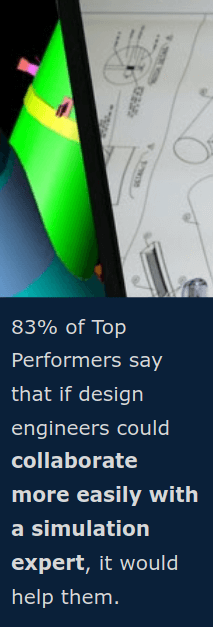 Getting More Value from Simulation
While simulation offers many advantages, there are opportunities to get even more value. Often, it is the lack of knowledge that holds them back. This is likely why 83% of Top Performers say that if design engineers could collaborate more easily with a simulation expert, it would help them.
Better Collaboration
The majority of respondents, 54%, agreed that the best way to enable collaboration between analysts and design engineers is to send a link to collaborate on a model in real-time. A cloud platform is a way to allow this, which is probably a contributor to why Top Performing companies are 3.9 times more likely to use cloud software, including for simulation.
While better collaboration is a powerful benefit, the leading advantage of those using simulation in the cloud, reported by 71%, is the additional computing power and faster results. Top Performers would use this extra time to complete design work faster, innovate more, and conduct additional simulations. The research also finds that those using simulation in the cloud report more benefits than anticipated by those who don't use it. This indicates that once you start using simulation in the cloud, it will likely help you in ways that you may not expect.
Easy Access to Needed Data
Another way to support design engineers is to make sure they have access to the required data to support simulations. The research finds that Top Performing companies are 63% more likely than Others to agree that the cloud is the ideal way to manage the different data types needed for simulation. Incidentally, those using the cloud for simulation are more likely to manage material data, best practices, test data, past simulations, and real-world performance data. Respondents identified all of these as data types that should be managed.
An Integrated Platform
The cloud is also a way of supporting an integrated platform. Companies reported many benefits of an integrated platform. Interestingly, the more complex the product, the more likely respondents were to report more benefits. Easier collaboration between design engineers and analysts, better traceability, more flexible licensing, ease of sharing and controlling access to results, and access to multiple physics were among the most commonly reported benefits.
Getting More Value from Simulation
While simulation offers many advantages, there are opportunities to get even more value. Often, it is the lack of knowledge that holds them back. This is likely why 83% of Top Performers say that if design engineers could collaborate more easily with a simulation expert, it would help them.
Better Collaboration
The majority of respondents, 54%, agreed that the best way to enable collaboration between analysts and design engineers is to send a link to collaborate on a model in real-time. A cloud platform is a way to allow this, which is probably a contributor to why Top Performing companies are 3.9 times more likely to use cloud software, including for simulation.
While better collaboration is a powerful benefit, the leading advantage of those using simulation in the cloud, reported by 71%, is the additional computing power and faster results. Top Performers would use this extra time to complete design work faster, innovate more, and conduct additional simulations. The research also finds that those using simulation in the cloud report more benefits than anticipated by those who don't use it. This indicates that once you start using simulation in the cloud, it will likely help you in ways that you may not expect.
Easy Access to Needed Data
Another way to support design engineers is to make sure they have access to the required data to support simulations. The research finds that Top Performing companies are 63% more likely than Others to agree that the cloud is the ideal way to manage the different data types needed for simulation. Incidentally, those using the cloud for simulation are more likely to manage material data, best practices, test data, past simulations, and real-world performance data. Respondents identified all of these as data types that should be managed.
An Integrated Platform
The cloud is also a way of supporting an integrated platform. Companies reported many benefits of an integrated platform. Interestingly, the more complex the product, the more likely respondents were to report more benefits. Easier collaboration between design engineers and analysts, better traceability, more flexible licensing, ease of sharing and controlling access to results, and access to multiple physics were among the most commonly reported benefits.
Recommendations
Recommendations and Next Steps Based on industry experience and research for this report, Tech-Clarity offers the following recommendations: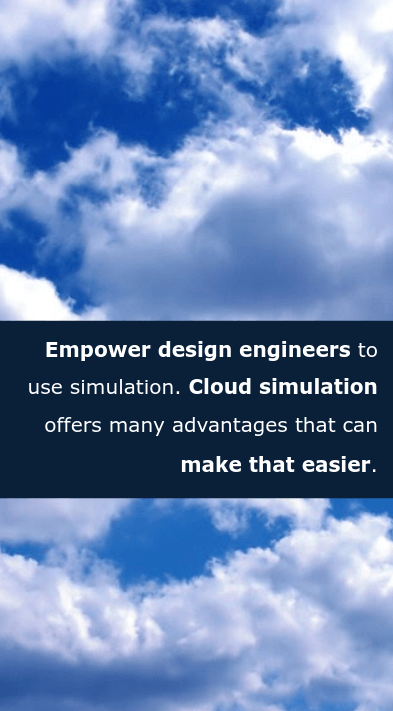 Empower design engineers to use simulation. Cloud simulation offers many advantages that can make that easier.
Empower design engineers to use simulation. Cloud simulation offers many advantages that can make that easier.- To support design engineers, facilitate easy and secure collaboration methods for them to connect with analysts. A cloud platform can support collaboration by merely sending a link to the model for real-time collaboration.
- Accelerate the time to get simulation results with cloud computing.
- Ensure design engineers have easy access to the needed data to support their simulations. Given the variety of different sources of data required to support simulation, the cloud is especially well suited to provide a single access point for the different data types.
- Consider an integrated platform to support simulation. Sudden market changes or supply chain disruptions can require significant changes to requirements. The traceability of an integrated platform to identify impacts, simulate new options, and update the design can be an invaluable way to adapt without hurting time to market.
- Enabling remote work
- Eliminating “wasted-time”
- Reducing design cycles
- Improving efficiency
- Preparing for “what’s next” by becoming more resilient and flexible


 [post_title] => Product Innovation in the new Normal (webcast)
[post_excerpt] =>
[post_status] => publish
[comment_status] => open
[ping_status] => open
[post_password] =>
[post_name] => product-innovation-webcast
[to_ping] =>
[pinged] =>
[post_modified] => 2022-11-14 22:27:04
[post_modified_gmt] => 2022-11-15 03:27:04
[post_content_filtered] =>
[post_parent] => 0
[guid] => https://tech-clarity.com/?p=10043
[menu_order] => 0
[post_type] => post
[post_mime_type] =>
[comment_count] => 0
[filter] => raw
)
)
[post_count] => 20
[current_post] => -1
[before_loop] => 1
[in_the_loop] =>
[post] => WP_Post Object
(
[ID] => 10432
[post_author] => 2572
[post_date] => 2021-05-05 17:12:39
[post_date_gmt] => 2021-05-05 21:12:39
[post_content] =>
[post_title] => Product Innovation in the new Normal (webcast)
[post_excerpt] =>
[post_status] => publish
[comment_status] => open
[ping_status] => open
[post_password] =>
[post_name] => product-innovation-webcast
[to_ping] =>
[pinged] =>
[post_modified] => 2022-11-14 22:27:04
[post_modified_gmt] => 2022-11-15 03:27:04
[post_content_filtered] =>
[post_parent] => 0
[guid] => https://tech-clarity.com/?p=10043
[menu_order] => 0
[post_type] => post
[post_mime_type] =>
[comment_count] => 0
[filter] => raw
)
)
[post_count] => 20
[current_post] => -1
[before_loop] => 1
[in_the_loop] =>
[post] => WP_Post Object
(
[ID] => 10432
[post_author] => 2572
[post_date] => 2021-05-05 17:12:39
[post_date_gmt] => 2021-05-05 21:12:39
[post_content] => 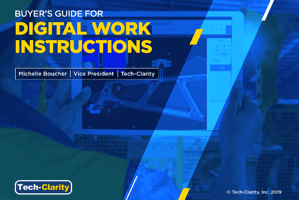 With increasing demands for highly skilled operators, yet a shortage of workers with those skills, what can manufacturers do to boost manufacturing productivity?
With workforce shortages, market volatility, and rising costs plaguing most manufacturers, many are turning to new ways of operating, and digital transformation is playing a pivotal role. Digital work instructions can be a critical component of the strategy, but what should you look for in a solution? This buyer’s guide* defines what digital work instructions are, the challenges they solve, and the benefits a company can realize by adopting them. The guide then outlines nine capabilities to look for in a solution.
While this buyer’s guide was written before the COVID-19 pandemic, the challenges facing manufacturers have not gone away, and in fact, in many cases have gotten even worse. Due to the pandemic, factories may need to get by with limited staff, while also coping with new safety guidelines. They also need to adapt to severe supply chain disruptions. Consequently, this has created demand for greater agility and efficiency, which has accelerated digital transformation. Access this buyer’s guide to learn about how digital work instructions can help.
Please enjoy the summary* below. For the full research, please visit our sponsor PTC (registration required).
With increasing demands for highly skilled operators, yet a shortage of workers with those skills, what can manufacturers do to boost manufacturing productivity?
With workforce shortages, market volatility, and rising costs plaguing most manufacturers, many are turning to new ways of operating, and digital transformation is playing a pivotal role. Digital work instructions can be a critical component of the strategy, but what should you look for in a solution? This buyer’s guide* defines what digital work instructions are, the challenges they solve, and the benefits a company can realize by adopting them. The guide then outlines nine capabilities to look for in a solution.
While this buyer’s guide was written before the COVID-19 pandemic, the challenges facing manufacturers have not gone away, and in fact, in many cases have gotten even worse. Due to the pandemic, factories may need to get by with limited staff, while also coping with new safety guidelines. They also need to adapt to severe supply chain disruptions. Consequently, this has created demand for greater agility and efficiency, which has accelerated digital transformation. Access this buyer’s guide to learn about how digital work instructions can help.
Please enjoy the summary* below. For the full research, please visit our sponsor PTC (registration required).
Table of Contents
- Challenges Facing Manufacturers
- What Are Digital Work Instructions?
- Ten Ways Digital Work Instructions Help
- 1. Connectivity to Existing Systems
- 2. Single Point of Access
- 3. Traceability from Engineering to Manufacturing
- 4. Supports Roll out of New or Customized Products
- 5. Real-Time Process Control
- 6. Analytics to Optimize Work Instructions
- 7. Hardware Agnostic
- 8. User friendly and Easy to Adopt
- 9. Good Vendor Support
- Select the Right Solution for Your Needs
- Acknowledgments
What Are Digital Work Instructions?
Industrial Internet of Things (IIoT) The IIoT integrates many technologies in a factory. It can create a digital thread across the product lifecycle, enabling traceability to support greater efficiency, improve quality, and support regulatory compliance. For many, investments in IIoT will likely create a competitive advantage, especially during a downturn. There are many different approaches to start with IIoT adoption. One way is with digital work instructions. The Difference Between Digital and Electronic
While digital work instructions support going paperless, digital is not the same as electronic. While an electronic format such as a PDF offers the benefits of going paperless, it does not provide all of the benefits of going digital. A PDF is still a dumb document. The minute you create it, you break the digital thread. The document has no link to its source data, so as soon as there are changes, the PDF is outdated.
Digital Work Instructions
On the other hand, digital work instructions are smart and data-driven. They preserve the digital thread from the engineering data and connect it to the produced product. Digital work instructions dynamically guide operators as they work, providing instructions in a digestible way that is easy to follow. The software can pull data from multiple places, yet only show the operator what’s relevant to the current task, from a single screen. Work instructions are never out of date since they automatically update when there are changes. With connectivity, the software also captures what the operators do. This closed loop visibility validates that the instructions were executed properly and provides management with visibility, supporting continuous improvement.
The Difference Between Digital and Electronic
While digital work instructions support going paperless, digital is not the same as electronic. While an electronic format such as a PDF offers the benefits of going paperless, it does not provide all of the benefits of going digital. A PDF is still a dumb document. The minute you create it, you break the digital thread. The document has no link to its source data, so as soon as there are changes, the PDF is outdated.
Digital Work Instructions
On the other hand, digital work instructions are smart and data-driven. They preserve the digital thread from the engineering data and connect it to the produced product. Digital work instructions dynamically guide operators as they work, providing instructions in a digestible way that is easy to follow. The software can pull data from multiple places, yet only show the operator what’s relevant to the current task, from a single screen. Work instructions are never out of date since they automatically update when there are changes. With connectivity, the software also captures what the operators do. This closed loop visibility validates that the instructions were executed properly and provides management with visibility, supporting continuous improvement.
Select the Right Solution for Your Needs
Recommendations Based on industry experience and research for this report, Tech-Clarity has identified the following criteria to select the right solution for digital work instructions:- Connectivity to existing systems
- Single point of access
- Traceability from engineering to manufacturing
- Supports roll out of new products or customized products
- Real-time process control
- Analytics to optimize work instructions
- Hardware agnostic
- User friendly and easy to adopt
- Good vendor support
All Results for "All"
How Software Enables Industrial Additive Manufacturing (webcast)
What role does software play in the maturation of additive manufacturing to industrial scale? This live webcast, hosted by Jim Brown and Igor Tsinman, President of AMC Bridge, explores the symbiotic relationship between additive manufacturing technology and the software applications that work cohesively with them. The panel includes Igal Kaptsan – General Manager Software of GE…
Michelle Boucher Speaks at Big Lever’s Momentum 2021 Symposium
What role should feature-based Product Line Engineering (PLE) play in a digital transformation strategy? On May 11-12, 2021, Big Lever will be holding their Momentum 2021 Symposium and this question will be the underlying theme of the event. Tech-Clarity’s Michelle Boucher will join the list of speakers and she will explore the question, why should…
PLM for the Medical Device Digital Thread (buyer’s guide)
How can PLM enable medical device companies to streamline engineering and create digital continuity with a cohesive medical device digital thread? What should they look for in a PLM solution to improve closed-loop quality and patient outcomes while meeting complex, regional compliance demands? This eBook takes a deeper dive into the data from our original, cross-industry digital thread study to…
Fill IoT Gaps with Low-Code (guest post)
How can low-code help fill digital transformation gaps to help companies achieve the value of IoT opportunities? Jim Brown’s guest post on Siemen’s blog shows how companies can fill IoT gaps with low-code applications. Below is a short summary, click here to read Jim Brown’s full guest post on the Siemen’s blog. Digital Transformation Creates Opportunities Today’s…
Can Low-Code Fill Gaps in Digital Transformation (survey results)
Digital transformation creates, exposes, and widens gaps in processes, organizational approaches, and systems. This leads 96% of industrial companies to say they need to create and implement new software more quickly. Addressing these application shortfalls is critical to long-term business success. Is developing applications with low-code the answer to filling the gaps? We surveyed over…
How Advanced Analytics in Manufacturing Can Lead to Cost Cuts (guest post)
Could deeper insights lower some manufacturing costs? For years, continuous improvement programs have successfully lowered operating costs. Now, companies are using advanced analytics in manufacturing to find even more opportunities. This is not your father’s analytics. Rather, it correlates among different data sources, including IoT, to deliver fresh insights for confidently moving to reduce costs….
Retool Semiconductor Innovation for Profit (survey results)
How can semiconductor companies make their product innovation even more profitable? By moving beyond technical prowess. By retooling innovation for a modern lifecycle management approach for digital continuity. This white paper is based on a Tech-Clarity survey of 277 semiconductor and high-tech professionals to find out how semiconductor companies manage product development and product lifecycles….
What is the Cost of Poor Quality in Your Manufacturing Environment? (guest post)
What does Poor Quality Really Cost? Calculating the actual cost of quality problems is not straightforward. Some of the expenses are apparent, but many are not. Quality is important to customers and to business profitability. So, truly understanding the cost of quality warrants the effort. Fortunately, advanced manufacturing technologies can help analyze and understand expenses…
Manufacturing Data: Can It Finally Flow? (guest blog)
What current challenge have manufacturers been wrestling with for at least 35 years? System integration. Getting manufacturing data to flow has always been a problem. And it still is. Based on Tech-Clarity research The Manufacturing Data Challenge: Lessons from Top Performers, most of the 300 respondents’ companies need better ways to integrate IT and OT data….
Lower Six Manufacturing Costs with IoT (eBook)
How can IoT and advanced technologies lower costs in manufacturing? Lower Six Manufacturing Costs with IoT explores how new technologies can help keep age-old manufacturing expenses in check. The report discusses how the Internet of Things (IoT) and related technologies for monitoring and using data can streamline processes and support people in making profitable decisions….
Choosing PLM for the A&D Digital Thread (survey results)
How can Aerospace and Defense (A&D) companies streamline collaboration and create digital continuity? What should they look for in a PLM system to support a cohesive digital thread, especially given that their IT systems were not designed for remote work during a pandemic? This eBook takes a deeper dive into the data from our original,…
Tech-Clarity adds Digital Innovation and Transformation Analyst James White
Tech-Clarity is pleased to announce that we are expanding our research team and extending our coverage of Digital Innovation, Digital Transformation, and Additive Manufacturing. Well-known industry thought leader and research analyst James White is joining Tech-Clarity as Vice President of Digital Innovation Research. James brings with him decades of experience in Digital Enterprise specializing in…
James White
James White is the Vice President of Digital Innovation Research for independent research firm Tech-Clarity. He covers the Digital Enterprise specializing in Digital Transformation, Design Innovation, PLM, Industrial Additive Manufacturing, BIM, and other solution areas for manufacturers. He began his career in special purpose machine design before moving into the CAD/CAE/PLM industry focused on heavy…
Are You Ready for Cloud PLM? (online assessment)
Is cloud PLM the right option for your company? If so, what do you need to know? Take our Cloud PLM Advisor assessment to find out. The assessment leverages our research to assess your company’s readiness to transition to the cloud. Should you switch to a new system? Wait for your current solution to be…
Benchmark Your IoT Machine Monitoring Capability (Performance Assessment)
How does your company stack up in its ability to monitor and optimize equipment performance using the IoT? Answer a few questions in our IoT Machine Monitoring Assessment and you’ll get a customized report that: Compares your capabilities to Top Performing companies Offers tailored recommendations to improve performance The assessment leverages our survey data to…
Semiconductor Innovation for Profitability (webcast)
Semiconductor innovation is multi-faceted; can lifecycle management improve product and thus business success? This on-demand webinar features Julie Fraser sharing Top Performers’ best practices for digital continuity based on her new semiconductor industry research. Semiconductor companies are great at technical innovation, but many do not have all the capabilities they need for product profitability. The…
Cloud-Based Simulation for Better Engineering
How can design engineers improve confidence in simulation results? Can cloud-based simulation help? Watch Michelle Boucher as she shares best practices from her research to explain how design engineers can get even more value from simulation. Simulation can be a powerful design tool by providing engineers with design guidance. However, some are concerned they lack the…
How to Survive and Win New Markets by Getting Even More Value from Simulation
How can design engineers get even more value from simulation? What is the most effective way to aid design engineers in their ability to create more competitive products? Our new eBook, How to Survive and Win New Markets by Getting Even More Value from Simulation explores these questions. Today’s challenging economic times, worsened by COVID-19,…
Product Innovation in the new Normal (webcast)
How can manufacturers innovate through today’s global industry disruption and set themselves up for success as things settle into a new normal? Hear from Kichler Lighting’s Mehul Gala, Tech-Clarity’s Jim Brown, and Onshape’s Dave Corcoran. They’ll share their perspectives on how companies are adapting to the new reality and preparing for the future by: Enabling…

